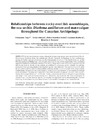Please use this identifier to cite or link to this item:
https://accedacris.ulpgc.es/jspui/handle/10553/49623
| Title: | Relationships between rocky-reef fish assemblages, the sea urchin Diadema antillarum and macroalgae throughout the Canarian Archipelago | Authors: | Tuya, Fernando Boyra, Arturo Sanchez-Jerez, Pablo Barbera, Carmen Haroun, Ricardo J. |
UNESCO Clasification: | 240106 Ecología animal 241713 Ecología vegetal 240210 Biología de poblaciones 241705 Biología marina 3105 Peces y fauna silvestre |
Keywords: | Urchin-fish interactions Trophic cascades Diadema antillarum Sea urchins Fish assemblages, et al |
Issue Date: | 2004 | Publisher: | 0171-8630 | Journal: | Marine Ecology - Progress Series | Abstract: | In situ visual surveys using a hierarchical sampling design were carried out at 36 sublittoral rocky locations along the central-east Atlantic Canarian Archipelago to find relationships among (1) benthic primary producers, (2) the demographic structure of the herbivorous sea urchin Diadema antillarum Phillipi and (3) the trophic structure of coastal fish communities. Our correlation approach displayed a relationship between the lack of large macroinvertebrate-eating predatory fish and the increase in density of sea urchins, in addition to a decrease in fish richness. In contrast, increases in fast-growing plankton-feeding fish species were detected. The size structure of D. antillarum is dominated by small-to-intermediate sized sea urchins in environments with a high density of individuals, whereas low sea urchin density locations are characterized by the dominance of large sized individuals. The physical complexity of the substrate seems to play an important role in determining the local patchiness of D. antillarum. Finally, a non-linear decrease in the percentage of fleshy macroalgal cover with increasing density of D. antillarum was observed. We therefore propose D. antillarum as a key herbivorous species, which plays an important role in determining the structure of shallow, hard-substratum, infralittoral benthic communities throughout the Canary Islands. | URI: | https://accedacris.ulpgc.es/handle/10553/49623 | ISSN: | 0171-8630 | DOI: | 10.3354/meps278157 | Source: | Marine Ecology Progress Series [ISSN 0171-8630], v. 278, p. 157-169 |
| Appears in Collections: | Reseña |
Items in accedaCRIS are protected by copyright, with all rights reserved, unless otherwise indicated.
